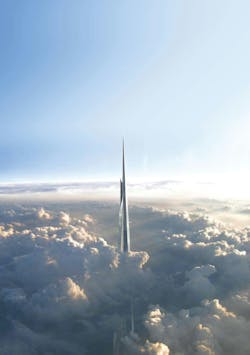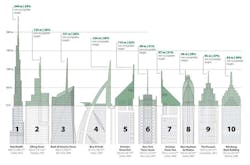'Vanity space' makes up large percentage of world's tallest buildings [infographic]
By BD+C Staff
It is known among tall-building architects that there are many tricks to increase the height of skyscrapers. But inflated skyscraper height came to the attention of the Council on Tall Buildings and Urban Habitat (CTBUH) last year after a case study suggested that the Kingdom Tower was designed with large decorative "vanity space" on top, inside of its spire, to enhance its height. Kingdom Tower, designed by Adrian Smith + Gordon Gill, is set to be the tallest tower in the world when built.
As a result, CTBUH performed a study which illustrates that large portions of some skyscrapers are actually useless space used to artificially enhance their height, Architizer reports. CTBUH created an infographic showcasing the vanity space phenomenon. Vanity space is defined as the distance between a skyscraper's highest occupiable floor and its architectural top.
Burj Khalifa, currently the tallest building on the globe, at 2,716 feet, has an 800-foot-tall unoccupied spire that accounts for nearly a third of its overall height. Ukraina Hotel in Moscow gets the award for having the largest percentage of vanity space: 42% of its 675 feet is unoccupied space.
See the infographic below, and you can read the full report here.
Courtesy of CBTUH

